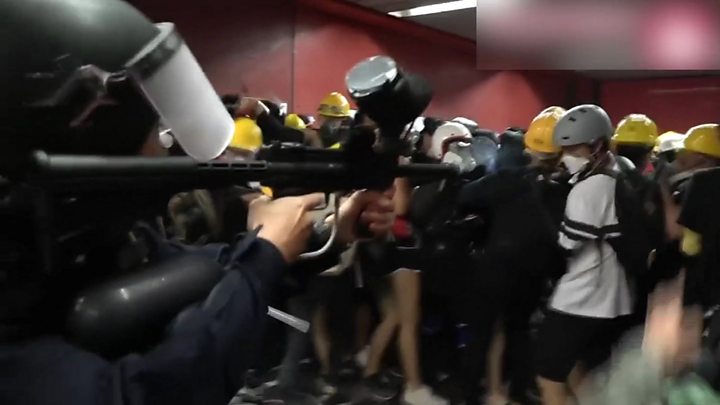Hong Kong police admit using ‘disguised’ officers
Hong Kong police have admitted deploying officers disguised as anti-government protesters during mass unrest that rocked the city on Sunday.
Some officers disguised themselves as “different characters”, a spokesman said, adding that the “decoy operation” had targeted “extreme violent rioters”.
It comes after video surfaced showing suspected undercover officers making arrests during Sunday’s clashes.
Protesters have called for an inquiry into the actions of the police.
Hong Kong’s mass demonstrations and unrest show no sign of abating, more than two months after they were sparked by a controversial extradition bill that has since been suspended.
On Monday, in a news conference that was at times heated, Deputy Police Commissioner Tang Ping-Keung defended the use of the “decoy officers”.
“I can say that during the time when our police officers were disguised… they [did not] provoke anything.” he said. “We won’t ask them to stir up trouble.”
“Our operation… is targeting extreme violent rioters,” he added. Mr Tang said police were responding to protesters who had used slings and hurled petrol bombs.
Another major development from the weekend in #HongKong was a new police tactic: undercover officers dress as protestors then, when the riot squad races in & activists start running, they grab demonstrators near them, throw them to the ground and pin them till other police come.
End of Twitter post by @StephenMcDonell
What else did police say?
Assistant Police Commissioner Mak Chin-ho, who also faced a volley of questions about Sunday’s violent scenes, said there was no evidence to suggest a woman had been shot by a police projectile.
Images of the woman, who was bleeding heavily from her eye, were shared widely on social media over the weekend.
On Monday, protesters at the city’s international airport wore bandages over their eyes in response to the incident.
There were confrontations in several central districts on Sunday and police used rubber bullets and tear gas in an attempt to disperse demonstrators.
Video also showed officers storming enclosed railway stations before firing tear gas inside and beating people with batons.
A number of people, including a police officer, were injured in the clashes.
Mr Mak also defended the use of pepper ball rounds at close range, saying officers made a “split-second” decision to fire on protesters who had tried to flee.
Beijing officials strongly condemned Sunday’s violence and linked violent protesters to “terrorism”.
What else is happening?
The city’s international airport cancelled all departures on Monday, as thousands of protesters occupied and caused disruption.
More than 160 flights were cancelled and officials blamed “seriously disrupted” operations.
As rumours spread that police planned to move in on protesters in the evening, thousands opted to leave on foot.
But hundreds of protesters remained camped in the terminals on Tuesday morning, despite an earlier statement from Hong Kong’s Airport Authority that said officials were hoping to reopen the airport by 06:00 local time (22:00 GMT).
One passenger, who wishes to remain anonymous, told the BBC they had been left stranded at the airport with “no food and no drinking water”.
“We have been completely abandoned by the airport staff,” they said. “People are sleeping on conveyor belts and hard floors.”
Separately, Hong Kong police have also unveiled a water cannon vehicle as a new tool to combat the protests.
Why are there protests in Hong Kong?
Demonstrations started in June in opposition to a proposed extradition bill, which would have allowed suspected criminals to be sent to mainland China for trial.
Critics said it would undermine Hong Kong’s legal freedoms, and could be used to silence political dissidents.
Although the government has now suspended the bill, demonstrators want it to be fully withdrawn.
Their demands have broadened to include calls for an independent inquiry into alleged police brutality, and an amnesty for all arrested protesters.
Hong Kong is part of China but its citizens have more autonomy than those on the mainland.
It has a free press and judicial independence under the so-called “one country, two systems” approach – freedoms which activists fear are being increasingly eroded.
Source: Read Full Article




